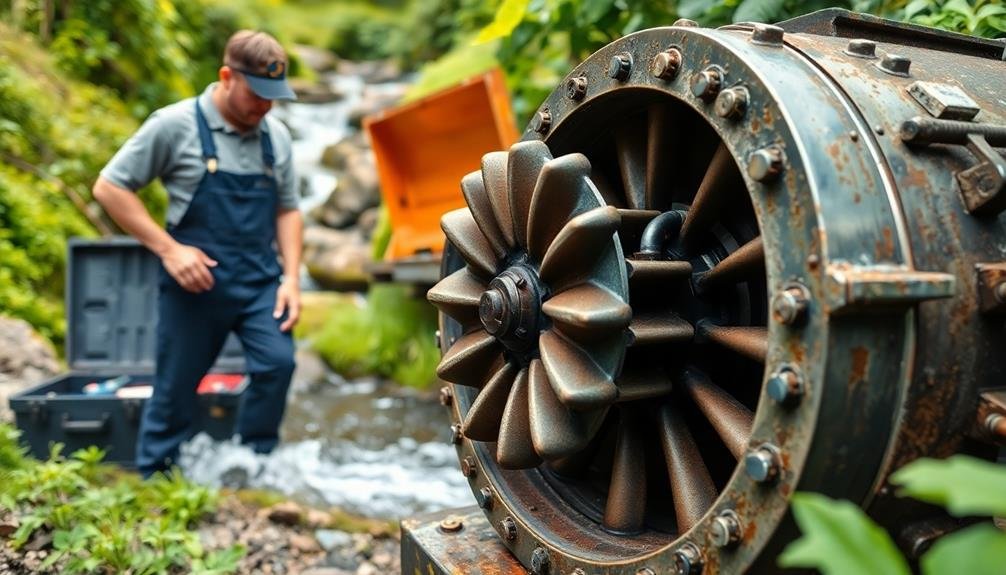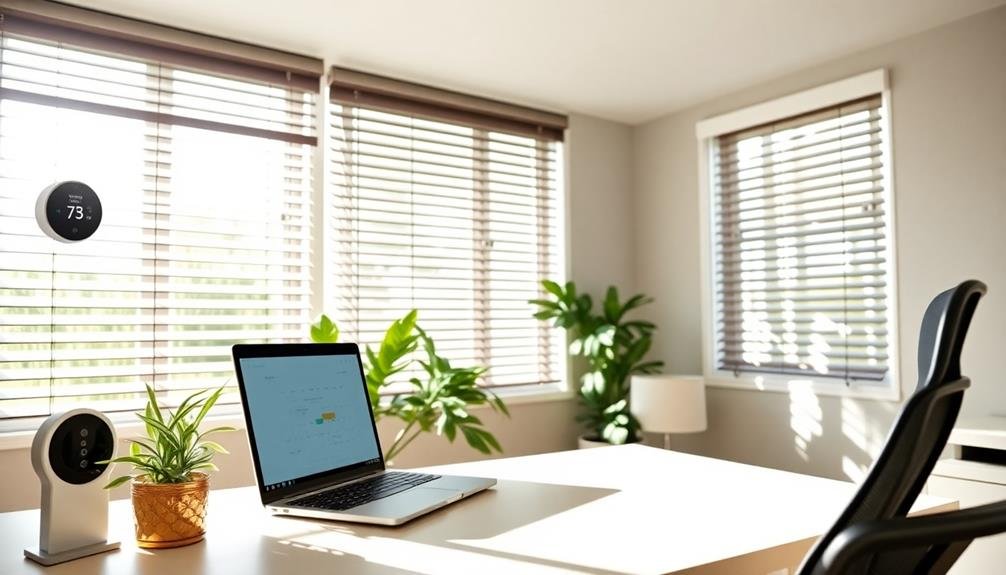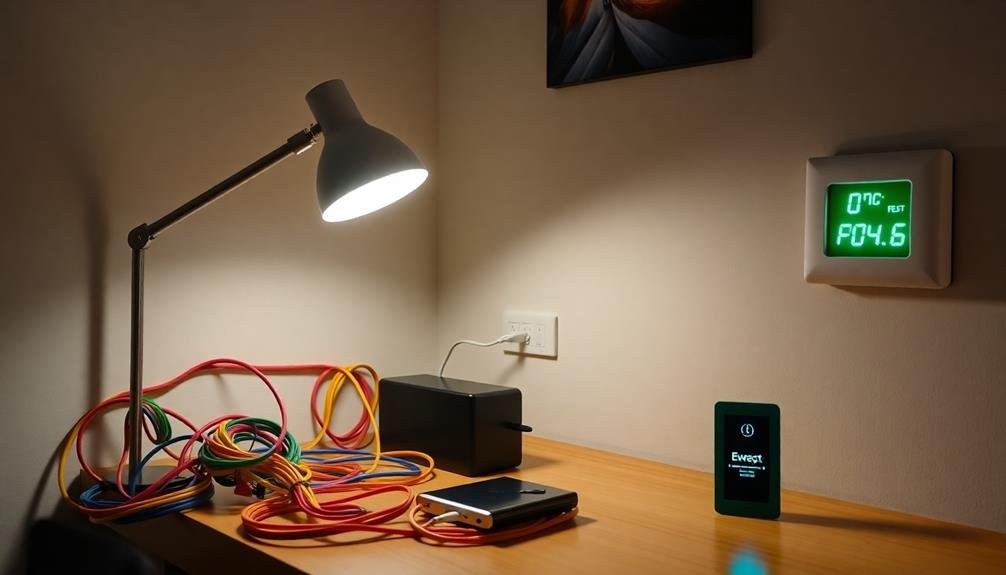To fix common micro-hydro system problems, start by checking water flow issues. Verify your intake isn't clogged and inspect the pipeline for leaks. For turbine troubles, look for blockages or damage and address bearing wear with proper lubrication. Keep an eye on generator temperature to prevent overheating. Don't forget to examine electrical connections and voltage regulation for stability. Regular maintenance is key – clean screens, monitor performance, and lubricate moving parts. By addressing these common issues promptly, you'll keep your micro-hydro system running smoothly. Dive deeper to master the art of troubleshooting and optimization.
Insufficient Water Flow

One of the most common issues plaguing micro-hydro systems is insufficient water flow. This problem can greatly reduce your system's power output, rendering it less effective or even unusable.
To address this, you'll need to first identify the cause. Check for any blockages in your intake pipe, such as debris or sediment buildup. Clean the pipe thoroughly and consider installing a more robust filtration system to prevent future clogs.
Next, examine your water source. Seasonal changes or drought conditions may have reduced the water level. If this is a recurring issue, you might need to relocate your intake to a deeper part of the stream or consider alternative water sources.
Leaks in the penstock can also lead to reduced flow. Inspect the entire length of your piping for any signs of damage or wear.
If these steps don't resolve the issue, you may need to reassess your system's design. Your turbine might be too large for your water source, or your pipe diameter could be insufficient.
Consult with a micro-hydro specialist to determine if system modifications are necessary to optimize performance given your available water resources.
Turbine Blockage or Damage
Frequently, turbine blockage or damage can greatly impair your micro-hydro system's performance. Debris, sediment, or foreign objects can obstruct the turbine's blades, reducing efficiency and potentially causing permanent damage.
You'll need to regularly inspect and clean your turbine to maintain peak operation.
If you suspect turbine blockage or damage, follow these steps:
- Shut down the system and disconnect power sources
- Carefully remove the turbine and inspect for visible obstructions or damage
- Clean the turbine thoroughly, removing any debris or buildup
Look for signs of wear, such as pitting, erosion, or bent blades. These issues can greatly reduce your system's output and may require professional repair or replacement.
If you're comfortable, you can attempt minor repairs yourself, but more complex problems should be addressed by a specialist.
To prevent future blockages, consider installing a debris screen or settling basin upstream from your intake. This will help filter out larger objects and sediment before they reach your turbine.
Additionally, implement a regular maintenance schedule to catch potential issues early and keep your micro-hydro system running smoothly.
Generator Overheating Issues

Generator overheating is a serious issue that can severely damage your micro-hydro system and reduce its lifespan. To prevent this problem, you'll need to identify the root cause and take appropriate action. Common reasons for generator overheating include inadequate cooling, excessive load, and poor ventilation.
First, check your cooling system. Verify that the water flow to the generator's cooling jacket is sufficient and unobstructed. Clean any debris or sediment that may have accumulated in the cooling channels. If you're using an air-cooled generator, make sure the cooling fins are clean and unobstructed.
Next, assess your system's load. Overloading the generator can cause it to overheat quickly. Use a power meter to measure the actual load and compare it to the generator's rated capacity. If necessary, reduce the load by disconnecting non-essential appliances or upgrading to a higher-capacity generator.
Proper ventilation is vital for maintaining ideal generator temperature. Confirm that your generator housing has adequate airflow and isn't obstructed by debris or vegetation. If needed, install additional vents or fans to improve air circulation.
Regularly monitor your generator's temperature using built-in gauges or external thermometers. If you notice persistent overheating issues, consult a micro-hydro specialist to diagnose and resolve more complex problems.
Electrical Connection Problems
Within micro-hydro systems, electrical connection problems can lead to inefficiency, system failures, and safety hazards. You'll need to address these issues promptly to maintain your system's performance and protect it from damage. Common electrical connection problems include loose connections, corrosion, and improper wiring.
To diagnose and fix electrical connection issues, follow these steps:
- Inspect all connections: Check for loose wires, frayed insulation, or signs of corrosion. Tighten any loose connections and replace damaged wires.
- Test continuity: Use a multimeter to check for breaks in the circuit. This will help you identify any disconnected or faulty wires.
- Verify grounding: Confirm all components are properly grounded to prevent electrical shocks and equipment damage.
You should also regularly clean and maintain your system's electrical components to prevent future problems. Use dielectric grease on connections to protect against moisture and corrosion.
If you're not comfortable working with electrical systems, don't hesitate to call a professional. Proper maintenance of electrical connections will help guarantee your micro-hydro system operates safely and efficiently for years to come.
Pipeline Leaks and Breaks

While electrical issues can cause significant problems, pipeline leaks and breaks pose a different set of challenges for micro-hydro systems. These issues can lead to reduced water flow, system inefficiency, and potential environmental damage. To address pipeline problems effectively, you'll need to regularly inspect your system and act quickly when issues arise.
Common signs of pipeline leaks or breaks include:
- Unexplained drops in water pressure
- Wet spots or erosion along the pipeline route
- Unusual sounds coming from the pipes
When you encounter these issues, use this troubleshooting guide:
| Problem | Possible Cause | Solution |
|---|---|---|
| Small leak | Loose fitting | Tighten or replace fitting |
| Crack in pipe | Freeze damage | Replace damaged section |
| Large rupture | Ground movement | Excavate and repair/replace |
To prevent future problems, consider implementing these measures:
- Install pressure relief valves to protect against sudden pressure spikes
- Use flexible pipe connections in areas prone to ground movement
- Insulate exposed pipes in cold climates to prevent freezing
Intake Screen Clogging
Keeping your micro-hydro system's intake screen clear is vital for maintaining ideal performance. Debris like leaves, twigs, and sediment can accumulate on the screen, reducing water flow and potentially damaging your turbine. Regular inspection and cleaning of the intake screen are important to prevent this issue.
You'll need to implement a routine maintenance schedule to keep your intake screen free from clogs. This often involves physically removing debris and cleaning the screen. In some cases, you might need to install a self-cleaning system or redesign your intake structure to minimize clogging.
Here are three effective methods to prevent and address intake screen clogging:
- Install a trash rack upstream of the intake to catch larger debris before it reaches the screen.
- Use an automated rake system that periodically clears the screen of accumulated material.
- Implement a bypass system that allows you to divert water flow while cleaning the screen.
If you're experiencing frequent clogging, consider upgrading to a coanda-effect screen, which can self-clean to some extent.
Voltage Regulation Failures

When your micro-hydro system experiences voltage regulation failures, you'll need to identify the root causes of voltage fluctuations.
You can start by examining common issues like generator speed inconsistencies, load changes, or faulty electronic components.
To resolve these problems, follow regulator troubleshooting steps and consider upgrading your voltage control systems for improved stability and performance.
Causes of Voltage Fluctuations
In micro-hydro systems, voltage fluctuations can stem from several key factors. Understanding these causes is vital for maintaining a stable power supply. Load variations, turbine speed changes, and generator issues are the primary culprits behind voltage instability.
When your system's load demand fluctuates rapidly, it can lead to voltage swings. This often happens when large appliances turn on or off, causing sudden spikes or dips in power consumption.
Turbine speed variations, usually due to inconsistent water flow or mechanical problems, can also result in voltage fluctuations. Your generator's performance plays a significant role too; worn brushes, loose connections, or faulty voltage regulators can all contribute to unstable output.
To identify and address these issues, consider the following steps:
- Monitor your system's load patterns and implement load management strategies
- Regularly inspect and maintain your turbine, ensuring proper alignment and lubrication
- Check your generator's components, including brushes, windings, and voltage regulator
Regulator Troubleshooting Steps
Voltage regulation failures can greatly impact your micro-hydro system's performance. To troubleshoot your regulator, start by checking its input and output voltages using a multimeter. Confirm the input voltage falls within the regulator's specified range. If it's too high or low, adjust your turbine's speed or load accordingly.
Next, inspect all wiring connections for loose or corroded terminals. Tighten any loose connections and clean corroded ones with a wire brush. Check the regulator's fuses and replace any that have blown.
If your regulator has a heat sink, make sure it's clean and adequately cooled. Test the regulator's internal components, such as diodes and capacitors, for proper functioning. Replace any faulty parts.
If your regulator is programmable, verify its settings are correct for your system's requirements. Consult the manufacturer's manual for specific programming instructions.
If these steps don't resolve the issue, consider replacing the regulator entirely. Choose a new one that matches your system's voltage and amperage requirements.
Remember to disconnect all power sources before working on electrical components, and if you're unsure about any step, consult a professional electrician for assistance.
Upgrading Voltage Control Systems
Upgrading your voltage control system can be a game-changer for addressing persistent regulation failures. If you've exhausted troubleshooting steps and still face issues, it's time to think about modernizing your equipment.
Modern voltage control systems offer improved efficiency, reliability, and precision, guaranteeing your micro-hydro setup maintains stable power output.
When upgrading, focus on these key areas:
- Digital controllers: Replace analog regulators with microprocessor-based units for more accurate voltage sensing and faster response times.
- Advanced sensing technology: Upgrade to multi-point voltage sensing systems that monitor various parts of your network, providing a more thorough view of your system's performance.
- Remote monitoring capabilities: Implement systems that allow for real-time data collection and remote adjustments, reducing the need for on-site maintenance.
Don't forget to evaluate your system's compatibility with new components before purchasing. You may need to update other parts of your micro-hydro setup to fully benefit from the upgraded voltage control system.
Think about consulting with a specialist to guarantee you're selecting the most appropriate upgrades for your specific needs and budget.
With the right improvements, you'll see a significant reduction in voltage regulation issues and enjoy more consistent power output from your micro-hydro system.
Bearing Wear and Lubrication
To prevent bearing failure in your micro-hydro system, you'll need to recognize early warning signs and implement proper lubrication techniques.
Watch for unusual noises, excessive vibration, or increased operating temperatures, as these can indicate impending bearing problems.
You can extend bearing life by using the correct type and amount of lubricant, maintaining a regular lubrication schedule, and ensuring your bearings are protected from contaminants.
Signs of Bearing Failure
In light of the critical role bearings play in micro-hydro systems, it's essential to recognize early signs of their failure. Being proactive in identifying these symptoms can prevent catastrophic breakdowns and costly repairs. Pay close attention to unusual noises, vibrations, or temperature changes in your system, as these are often the first indicators of bearing issues.
When inspecting your micro-hydro system, look for these telltale signs of bearing failure:
- Excessive heat: Feel the bearing housing for abnormal warmth. If it's too hot to touch comfortably, there may be inadequate lubrication or misalignment.
- Unusual sounds: Listen for grinding, squealing, or clicking noises, which can indicate contamination, lack of lubrication, or structural damage.
- Increased vibration: Use a vibration meter or place your hand on the equipment to detect unusual shaking or trembling, which may signal bearing wear or imbalance.
Don't ignore these warning signs, as they can quickly escalate into more serious problems. Regular maintenance and prompt attention to these indicators will help extend the life of your bearings and guarantee the continued efficiency of your micro-hydro system.
Proper Lubrication Techniques
Proper lubrication is essential for maintaining the health and longevity of bearings in your micro-hydro system. To guarantee peak performance, you'll need to choose the right lubricant, apply it correctly, and maintain a consistent schedule.
When selecting a lubricant, consider your system's operating conditions, such as temperature, speed, and load. Use high-quality, water-resistant greases or oils specifically designed for hydro turbines. Apply the lubricant evenly, making sure to cover all moving parts without over-greasing.
Here's a quick reference guide for lubricating different bearing types:
| Bearing Type | Lubricant | Application Method |
|---|---|---|
| Ball Bearings | Grease | Grease gun |
| Roller Bearings | Oil | Oil bath or drip feed |
| Sleeve Bearings | Oil | Oil rings or wick feed |
Establish a regular lubrication schedule based on your system's operating hours and manufacturer recommendations. Don't forget to inspect bearings for signs of wear or contamination during each lubrication session.
Remember to clean the area around bearings before applying new lubricant, and always use clean tools to prevent introducing contaminants. By following these proper lubrication techniques, you'll greatly extend the life of your micro-hydro system's bearings and minimize downtime.
Frequently Asked Questions
How Often Should I Perform Maintenance on My Micro-Hydro System?
You should perform routine maintenance on your micro-hydro system monthly. However, you'll need to do more thorough checks quarterly and annually. Don't forget to inspect after storms or heavy rainfall. Regular upkeep guarantees peak performance.
Can I Install a Micro-Hydro System in an Area With Freezing Temperatures?
Yes, you can install a micro-hydro system in freezing areas. You'll need to take precautions like insulating pipes, using heat tape, and ensuring water flow doesn't stop. It's challenging but doable with proper planning and maintenance.
What Permits Are Required for Installing a Micro-Hydro System?
You'll typically need water rights, environmental permits, and local building permits. Don't forget to check with your utility company for grid connection requirements. Always consult local authorities to guarantee you're complying with all regulations.
How Do I Calculate the Potential Power Output of My Micro-Hydro Site?
To calculate your micro-hydro site's potential power output, you'll need to measure the head (vertical drop) and flow rate. Multiply these values with gravity and efficiency factors. Use the formula: Power = Head x Flow x Gravity x Efficiency.
Are There Any Environmental Impacts Associated With Micro-Hydro Systems?
Yes, micro-hydro systems can have environmental impacts. You'll need to contemplate fish migration, water quality, and habitat disruption. However, they're generally less impactful than larger hydropower projects. Proper design and management can minimize these effects.
In Summary
You've now got the knowledge to tackle common micro-hydro system issues. Remember, regular maintenance is key to preventing problems. Don't hesitate to inspect your system often and address issues promptly. If you're ever unsure, it's wise to consult a professional. With proper care and attention, your micro-hydro system will continue to provide clean, renewable energy for years to come. Keep learning and stay proactive in your system's upkeep.





Leave a Reply